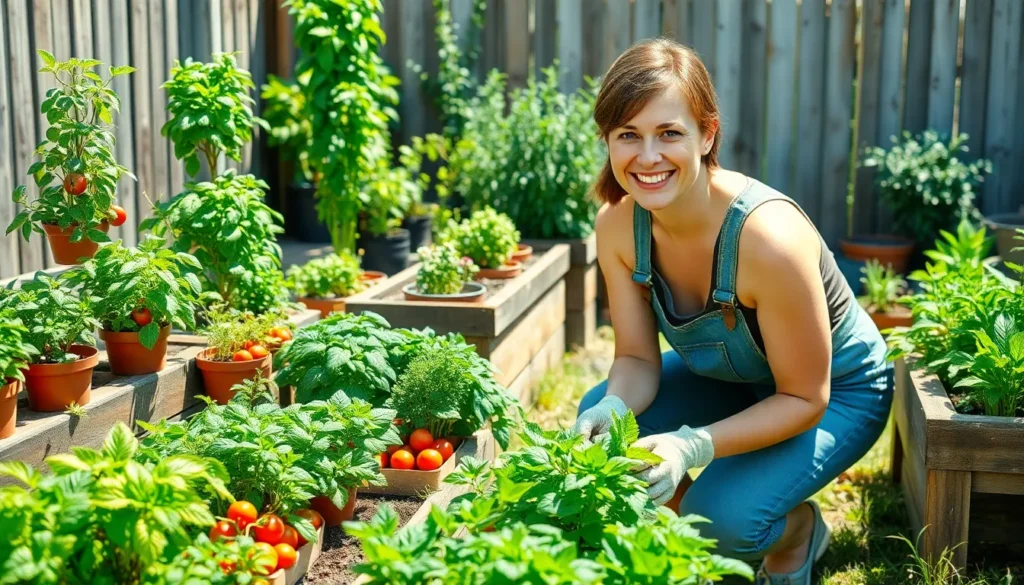Growing our own kitchen garden transforms the way we cook and eat while connecting us to nature’s bounty right outside our door. Whether we’re seasoned gardeners or complete beginners, creating a thriving garden space that supplies fresh herbs, vegetables, and fruits for our daily meals is more achievable than we might think.
We’ve compiled innovative and practical kitchen garden ideas that work for every space – from sprawling backyards to tiny urban balconies. These creative answers maximize our growing potential while fitting seamlessly into our lifestyle and available space.
The beauty of kitchen gardening lies in its flexibility and immediate rewards. We’ll explore container gardens, vertical growing systems, herb spirals, and companion planting strategies that’ll have us harvesting fresh ingredients within weeks. Let’s jump into these game-changing ideas that’ll revolutionize how we approach home-grown food.
Start Small With Container Gardening Ideas for Kitchen Garden Success
Container gardening offers us the perfect entry point into kitchen gardening, especially when we’re working with limited space or want to test our green thumb before committing to larger projects.
Choose the Right Size Containers
Selecting containers that match our plants’ root systems ensures healthy growth and abundant harvests. Small herbs like basil, oregano, and thyme thrive in 6-8 inch pots, while leafy greens such as lettuce, spinach, and kale need containers at least 6-8 inches deep with a 12-inch diameter. Deeper root vegetables like carrots, radishes, and beets require containers 10-12 inches deep, and tomatoes, peppers, and eggplants need substantial 5-gallon containers or larger.
Matching container depth to plant requirements prevents root binding and nutrient deficiencies. We can maximize our space by grouping plants with similar depth needs together. Bush beans work well in 8-10 inch deep containers, while climbing varieties need deeper 12-15 inch pots plus vertical support structures.
Select Appropriate Drainage Answers
Proper drainage prevents root rot and maintains healthy soil conditions for our container plants. We should ensure every container has drainage holes spaced 2-3 inches apart across the bottom surface. Adding a layer of gravel, broken pottery, or expanded clay pebbles creates additional drainage space beneath the soil.
Installing saucers or drip trays protects our surfaces while monitoring water levels. We can drill additional holes if water pools after heavy watering sessions. Self-watering containers with built-in reservoirs work exceptionally well for herbs like parsley, cilantro, and chives that prefer consistent moisture levels.
Pick Portable Options for Flexibility
Choosing lightweight, moveable containers allows us to optimize sun exposure and protect plants from harsh weather. Fabric grow bags, plastic pots with handles, and wheeled planters make repositioning effortless throughout growing seasons. We can move sun-loving plants like tomatoes and peppers to follow optimal light patterns during the day.
Portable containers enable us to bring tender plants indoors during cold snaps or extreme heat. Rolling carts accommodate multiple smaller pots and create mobile garden stations we can relocate as needed. Stackable containers maximize vertical growing space while maintaining portability for seasonal adjustments.
Create a Dedicated Herb Garden Space Near Your Kitchen
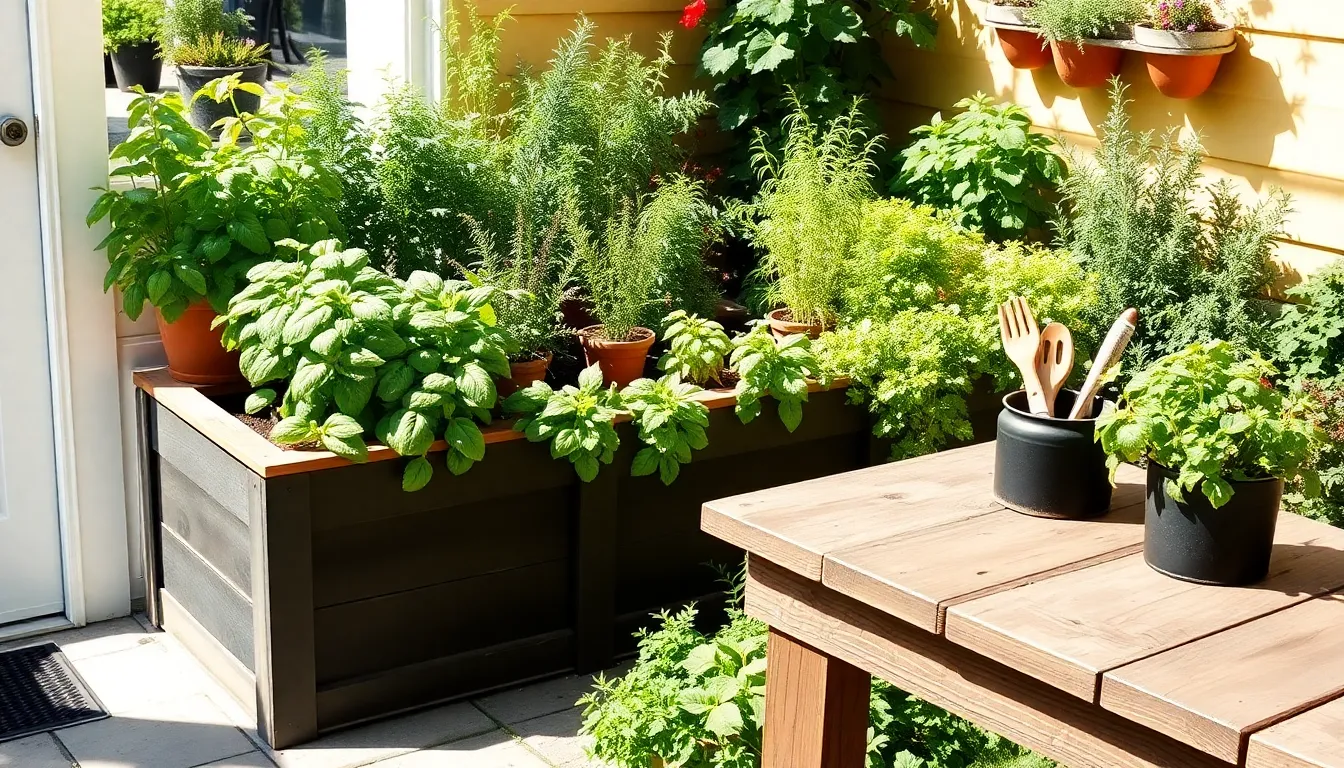
Building our herb garden directly beside our kitchen door transforms daily cooking from ordinary meal prep into fresh, flavorful experiences. We’ll maximize convenience and encourage regular harvesting by positioning herbs within arm’s reach of our culinary workspace.
Position Herbs Within Easy Reach
Positioning herbs within a few steps of our kitchen entrance eliminates barriers to using fresh ingredients daily. We can create raised beds directly outside our kitchen door or install window boxes on nearby sills for instant access. Placing herb containers on rolling carts allows us to move plants closer when harvesting and return them to optimal growing spots afterward.
Strategic placement means we won’t need to walk across our entire yard just to grab fresh basil for tonight’s pasta sauce. We should arrange frequently used herbs like parsley and chives in the closest spots to our kitchen while positioning occasional use herbs like rosemary slightly further away. Container gardens work exceptionally well for this approach since we can relocate pots based on seasonal cooking needs.
Group Herbs by Water and Light Requirements
Grouping herbs according to their growing needs prevents overwatering some plants while underwatering others in our dedicated space. Mediterranean herbs like thyme, oregano, and sage thrive in well-draining soil with less frequent watering. We can plant these together in one raised bed or container grouping.
Moisture loving herbs such as parsley, cilantro, and mint require more consistent watering and slightly richer soil conditions. Creating separate planting areas for these herbs ensures each group receives appropriate care without compromising plant health. Sun requirements also play a crucial role in our grouping strategy, with full sun herbs like rosemary separated from partial shade lovers like parsley.
| Herb Group | Water Needs | Light Requirements | Examples |
|---|---|---|---|
| Mediterranean | Low to moderate | Full sun | Thyme, oregano, sage |
| Moisture loving | Regular watering | Partial sun | Parsley, cilantro, mint |
| Leafy greens | Consistent moisture | Partial shade | Basil, chives, dill |
Include Essential Cooking Herbs
Including essential cooking herbs ensures our kitchen garden delivers maximum culinary value for our daily meal preparation. Basil stands as the most versatile herb for our collection, perfect for everything from caprese salads to homemade pesto. Fresh thyme elevates roasted vegetables and meat dishes while providing year round harvests in most climates.
Rosemary brings robust flavor to grilled meats and roasted potatoes, plus its woody stems double as natural skewers for kebabs. Parsley serves dual purposes as both a garnish and flavor enhancer in soups, sauces, and marinades. We should also consider adding oregano for pizza and pasta dishes, sage for fall cooking, and chives for egg dishes and salads.
Practical herb selection focuses on varieties we actually use rather than exotic options that might go unharvested. Starting with these six essential herbs provides enough variety to transform our cooking while keeping maintenance manageable for busy schedules.
Design Vertical Growing Systems to Maximize Space
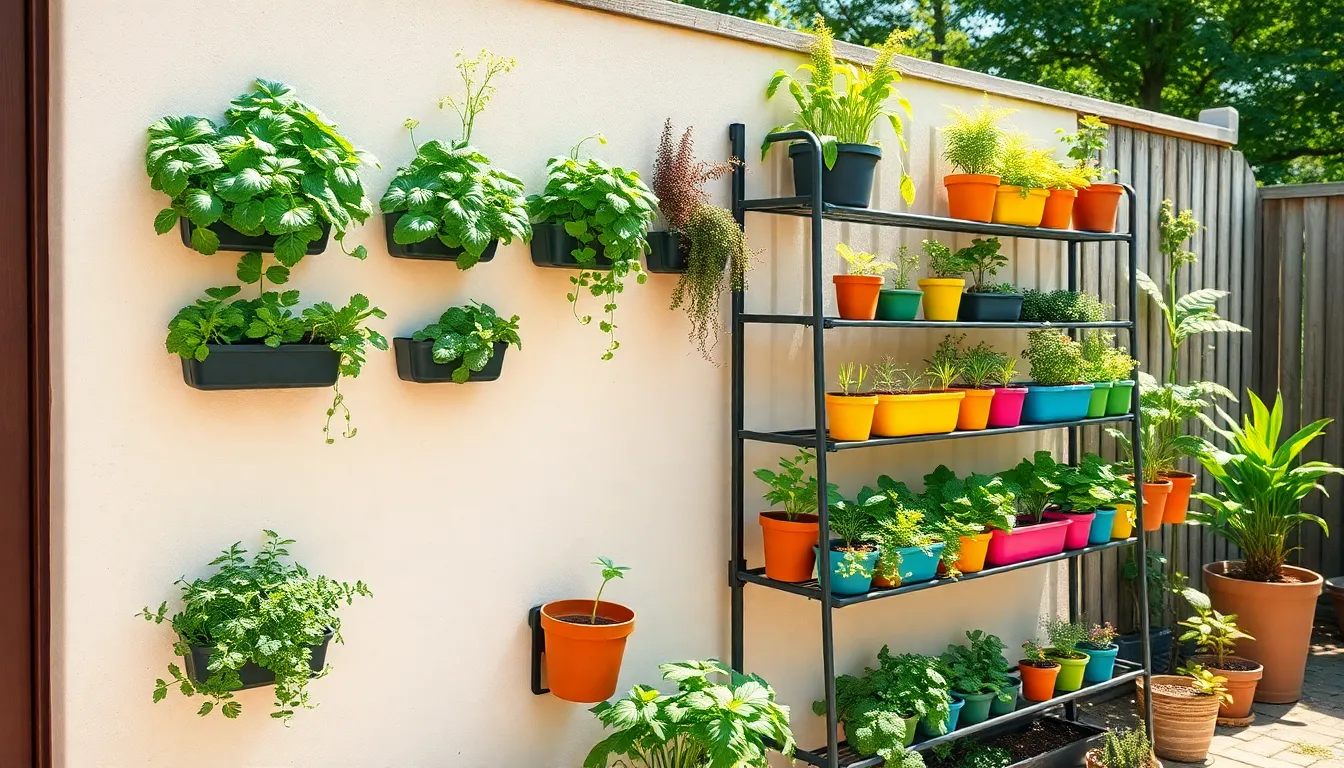
When ground space is limited, we can expand our kitchen garden upward with smart vertical answers. These innovative growing systems multiply our planting area while keeping plants easily accessible for daily harvesting.
Install Wall-Mounted Planters
Modular planting units transform any wall into productive growing space for herbs, leafy greens, and compact vegetables. We can install these versatile systems on fences, garage walls, or even interior kitchen walls near windows. The modular design lets us rearrange planters as our plants grow or seasons change.
Pocket planters made from fabric or canvas offer another flexible wall-mounted option. These lightweight systems hang easily from hooks or brackets and can be moved seasonally to follow optimal sun exposure. Each pocket holds individual plants like herbs, lettuce, or strawberries perfectly.
Build Tiered Garden Shelves
Multi-tiered container systems maximize vertical space by stacking smaller pots on top of larger ones. We can create these arrangements using existing containers of different sizes, ensuring proper drainage between levels. This method works exceptionally well for herbs and small vegetables that don’t require deep root systems.
Shelving structures provide stable platforms for multiple plant containers at varying heights. Building or purchasing tiered shelving allows us to organize plants by height, sun requirements, or harvest timing. The structure makes maintenance and watering straightforward while creating visual appeal.
Use Hanging Basket Arrangements
Suspended baskets add growing space above eye level for trailing plants like cherry tomatoes, strawberries, and cascading herbs. We can hang these from pergolas, tree branches, or ceiling hooks on covered patios. The hanging motion also helps with air circulation around plants.
Multi-level hanging shelves with multiple baskets create vertical gardens that use minimal floor space. These arrangements work particularly well in narrow areas like balconies or along pathways. Each shelf can hold different plant varieties based on their light and water needs.
Plan a Year-Round Indoor Growing Setup
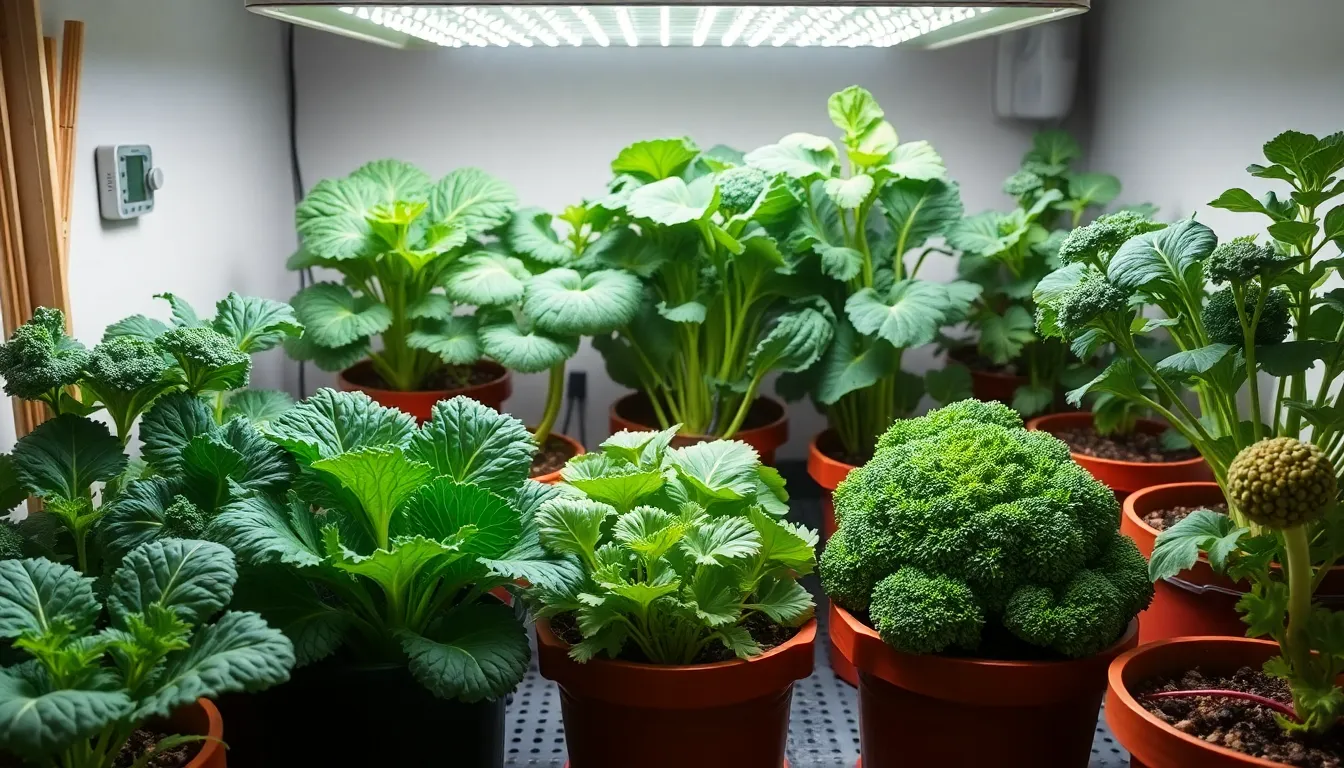
Indoor growing allows us to enjoy fresh produce throughout the year, regardless of outdoor weather conditions. We can create a thriving kitchen garden indoors by focusing on three essential elements that ensure consistent harvests.
Select Cold-Hardy Winter Vegetables
Cold-hardy vegetables form the backbone of our winter indoor garden because they naturally tolerate lower temperatures and shorter daylight hours. We should prioritize vegetables that thrive in temperatures below 40°F (4°C), such as kale and spinach, which actually develop sweeter flavors in cooler conditions.
Brussels sprouts and broccoli offer excellent options for indoor cultivation since they perform well in the 40°F to 75°F (4°C to 24°C) temperature range. These vegetables adapt easily to container growing and provide substantial harvests throughout the darker months.
| Vegetable | Ideal Temperature Range |
|---|---|
| Kale | Below 40°F (4°C) |
| Spinach | Below 40°F (4°C) |
| Broccoli | 40°F to 75°F (4°C to 24°C) |
| Brussels Sprouts | 40°F to 75°F (4°C to 24°C) |
Leafy greens like arugula, lettuce, and Swiss chard also thrive in cooler indoor environments and mature quickly for continuous harvesting.
Invest in Grow Lights for Dark Months
Quality grow lights become essential during winter months when natural sunlight decreases significantly in both intensity and duration. LED lights offer the most efficient option for our indoor gardens because they produce less heat while delivering the full spectrum of light that plants need for photosynthesis.
Full spectrum LED grow lights can supplement or completely replace natural light, allowing us to maintain consistent growing conditions year-round. We should position lights 12 to 24 inches above our plants and run them for 12 to 16 hours daily to simulate longer growing seasons.
Timer-controlled lighting systems help us maintain consistent light schedules without daily monitoring. Modern LED systems consume less energy than traditional fluorescent lights while producing better results for vegetable growth.
Maintain Consistent Temperature Control
Temperature consistency plays a crucial role in successful year-round indoor growing because fluctuations stress plants and reduce productivity. We need to maintain temperatures between 65°F to 75°F (18°C to 24°C) for optimal growth of most vegetables and herbs.
Space heaters with thermostats help us regulate temperature in dedicated growing areas during colder months. Insulating our growing space with thermal curtains or moving plants away from drafty windows prevents temperature swings that can shock sensitive plants.
Monitoring devices like digital thermometers with min/max memory functions allow us to track temperature variations throughout the day. We can adjust our setup based on this data to create the most stable environment possible for our indoor kitchen garden.
Incorporate Raised Bed Ideas for Kitchen Garden Organization
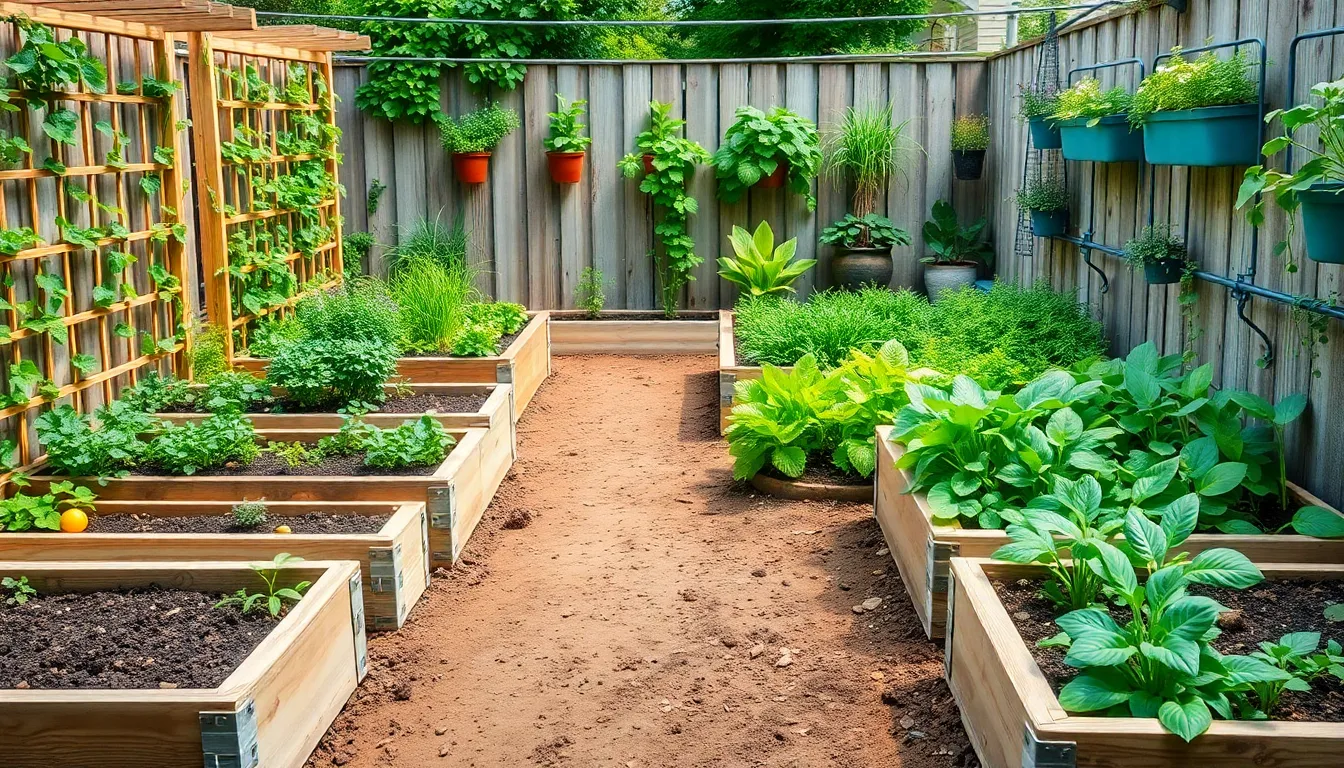
Raised beds transform our kitchen garden into an organized and efficient growing space that delivers better harvests with less maintenance. We’ll explore unique structures and strategic organization methods that make our garden both productive and visually appealing.
Build Accessible Height Structures
Trellises and arches create vertical growing opportunities for climbing plants like cucumbers, tomatoes, and beans while adding visual appeal to our garden layout. We can install these structures within our raised beds to maximize growing space and support heavy-producing vines that might otherwise sprawl across the ground.
Wall-mounted planters transform vertical surfaces into productive growing areas, especially useful when we’re working with limited ground space. We attach these directly to fences, walls, or the sides of our raised beds to grow herbs and smaller vegetables at eye level.
Tiered shelving systems allow us to stack containers at different heights, creating accessible growing levels that make harvesting easier on our backs. We position frequently used herbs and greens on the higher tiers while placing heavier vegetables like tomatoes and peppers on lower, more stable levels.
Unique raised half-moon beds made from Corten steel or powder-coated metal provide modern aesthetics while offering excellent durability for our long-term gardening plans. We can use these curved designs in narrow spaces or as decorative elements that add warmth and elegance to our overall garden design.
Create Separate Sections for Different Crops
Crop segregation systems help us organize our raised beds based on plant families and growing requirements, making maintenance tasks more efficient and reducing pest and disease problems. We divide our four raised garden beds to accommodate leafy greens in one section, root vegetables in another, and herbs in a dedicated third area.
Companion planting zones allow us to group plants that benefit each other, such as placing basil near tomatoes or carrots alongside onions. We design these sections to take advantage of natural pest deterrent properties while maximizing our growing space efficiency.
Seasonal rotation areas enable us to plan ahead for crop changes throughout the year, ensuring our soil remains healthy and productive. We designate exact beds for cool-season crops like spinach and kale, while reserving others for warm-season vegetables like peppers and eggplant.
Mixed planting arrangements incorporate flowers among our vegetables to enhance visual appeal while attracting beneficial insects that support our garden’s network. We strategically place marigolds, nasturtiums, and calendulas throughout our vegetable sections to create a beautiful and functional growing environment.
Install Efficient Irrigation Systems
Drip irrigation networks deliver water directly to plant roots, reducing water waste by up to 50% compared to traditional sprinkler systems while preventing leaf diseases caused by overhead watering. We install these systems along our raised bed edges with individual emitters positioned near each plant for precise water delivery.
Soaker hoses provide consistent moisture throughout our growing beds while requiring minimal installation effort and maintenance. We lay these porous hoses along our planting rows and connect them to timers for automated watering schedules that adapt to our plants’ changing needs.
Smart irrigation controllers monitor soil moisture levels and weather conditions to adjust watering schedules automatically, ensuring our plants receive optimal hydration without waste. We connect these systems to our smartphones for remote monitoring and control, making garden management convenient even when we’re away from home.
Rainwater collection systems capture and store natural precipitation for use during dry periods, reducing our reliance on municipal water supplies while providing our plants with chemical-free irrigation. We install gutters and downspouts to direct roof runoff into storage barrels positioned strategically around our raised bed areas.
Choose Fast-Growing Vegetables for Quick Harvests
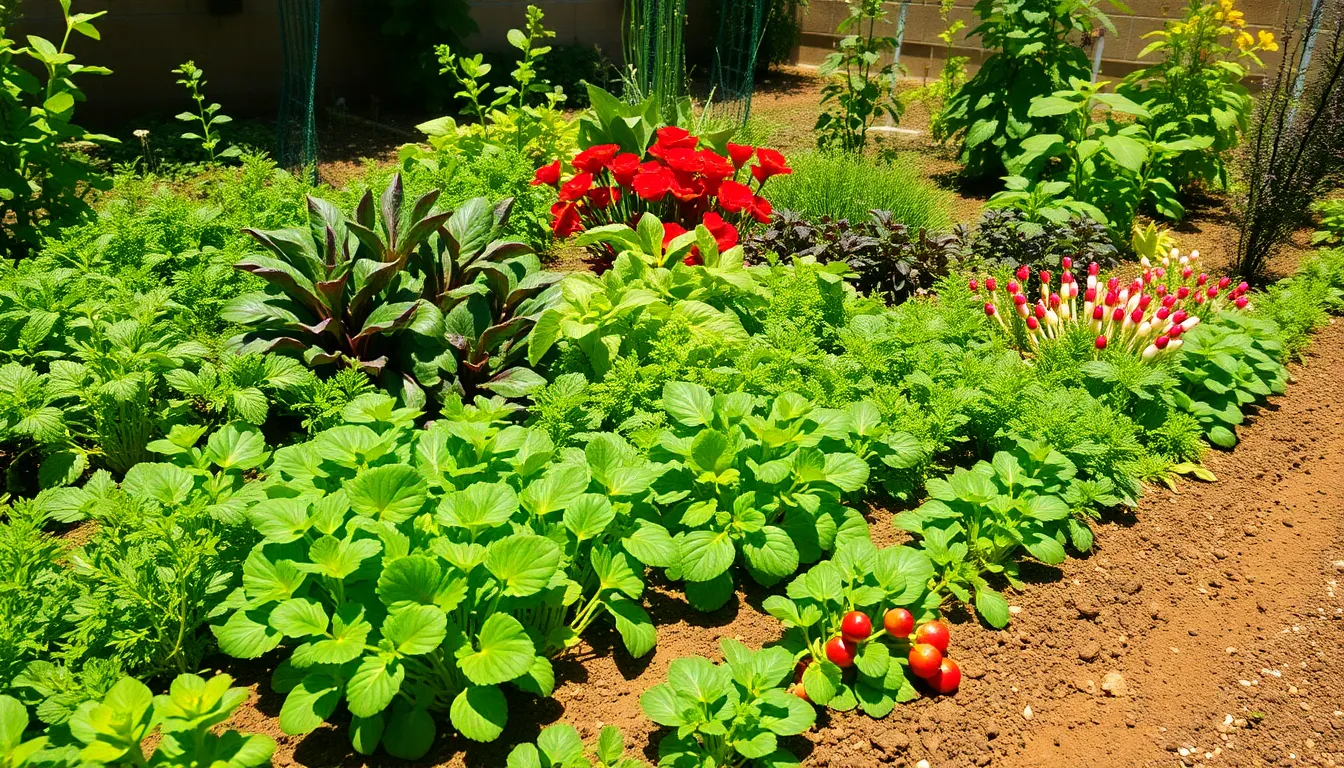
Nothing beats the satisfaction of harvesting fresh vegetables just weeks after planting. We can transform our kitchen garden into a productive space by selecting varieties that mature quickly and provide continuous yields throughout the growing season.
Plant Leafy Greens and Microgreens
Leafy greens offer some of the fastest returns in our kitchen garden, with many varieties ready for harvest in under 50 days. Arugula stands out as an exceptional choice, maturing in approximately 50 days and providing continuous harvests when we cut the outer leaves regularly. Spinach delivers nutrient-rich harvests in just 28 to 42 days, making it perfect for fresh salads and cooked dishes.
Mizuna brings a unique peppery flavor similar to arugula, featuring distinctive serrated leaves that add visual appeal to our harvests. This heat-tolerant green performs exceptionally well when harvested young, typically within 40 days of planting. Lettuce and spring mix varieties complete our quick-growing collection, reaching maturity in 45 to 50 days and providing the foundation for countless salad combinations.
Grow Radishes and Quick Root Vegetables
Root vegetables can surprise us with their rapid growth, especially when we choose the right varieties for our kitchen garden. Radishes lead the pack as some of the fastest vegetables we can grow, with most varieties ready for harvest in just 20 to 30 days. French Breakfast radishes offer reliability and versatility, while De 18 Jours radishes set the speed record at an impressive 18 days from seed to harvest.
Beets provide slightly longer growing times but still deliver relatively quick results at approximately 60 days. These colorful root vegetables offer dual harvests since we can use both the roots and the nutrient-rich greens in our cooking.
Select Cut-and-Come-Again Varieties
Cut-and-come-again varieties revolutionize our kitchen garden efficiency by allowing continuous harvesting without replanting. Arugula and mizuna excel as cut-and-come-again options, enabling us to harvest outer leaves while the center continues producing new growth.
These varieties extend our yield significantly from a single planting, making them ideal for maximizing space and minimizing replanting efforts. We can maintain steady harvests for weeks by cutting leaves when they reach 4 to 6 inches in length, leaving the growing points intact for continued production.
Establish Companion Planting Strategies
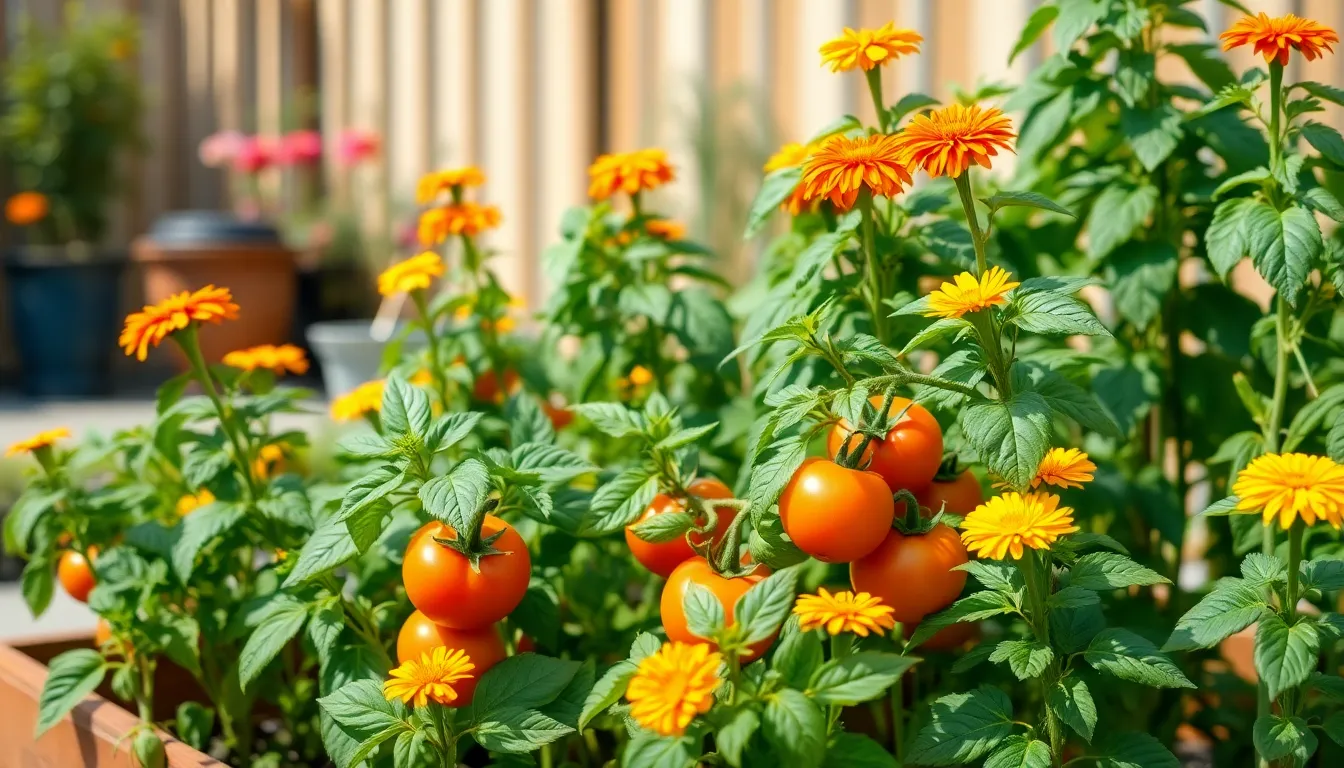
Successful companion planting transforms our kitchen garden into a naturally balanced network where plants support each other’s growth. We’ll explore strategic plant partnerships that maximize yields while reducing pest problems and improving soil health.
Pair Compatible Plants Together
Tomatoes and basil create one of the most effective partnerships in our kitchen garden. Basil enhances tomato yields while naturally repelling flies and mosquitoes that commonly attack tomato plants. We’ve found this combination particularly successful when we plant basil around the base of tomato plants.
Marigolds paired with tomatoes provide exceptional pest protection throughout the growing season. These vibrant flowers deter nematodes and other harmful pests that typically damage tomato root systems. Planting marigolds in a border around our tomato beds creates a protective barrier that keeps our harvest healthy.
Carrots and onions form another powerful duo that we regularly carry out in our garden beds. Onions effectively repel carrot flies, which are the primary pest that damages carrot crops. Interplanting these vegetables in alternating rows has significantly improved our carrot harvests while maximizing space efficiency.
Use Natural Pest Control Methods
Herbs serve as living pesticides that we strategically place throughout our garden for maximum protection. Lavender, mint, basil, and rosemary naturally repel aphids, mosquitoes, and flea beetles without harmful chemicals. These aromatic plants create protective zones around vulnerable vegetables while providing fresh ingredients for our kitchen.
Marigolds function as multipurpose pest deterrents that we use to protect various crops simultaneously. They repel nematodes, whiteflies, and many other garden pests through their strong scent and root compounds. We plant marigolds as border plants and scatter them throughout vegetable beds for comprehensive protection.
Maximize Soil Nutrition Benefits
Composting enhances our companion planting success by providing the rich nutrients that plant partnerships need to thrive. Adding compost to our garden beds improves plant health and strengthens the beneficial relationships between companion plants. We’ve noticed that well composted soil produces stronger pest resistance and higher yields in our companion plantings.
Crop rotation prevents nutrient depletion while maintaining the effectiveness of our companion planting strategies. Moving plants to different locations each season reduces disease risk and keeps soil fertility balanced. We plan our companion plant combinations around our rotation schedule to maximize both soil health and plant partnerships.
Set Up Efficient Watering and Maintenance Systems
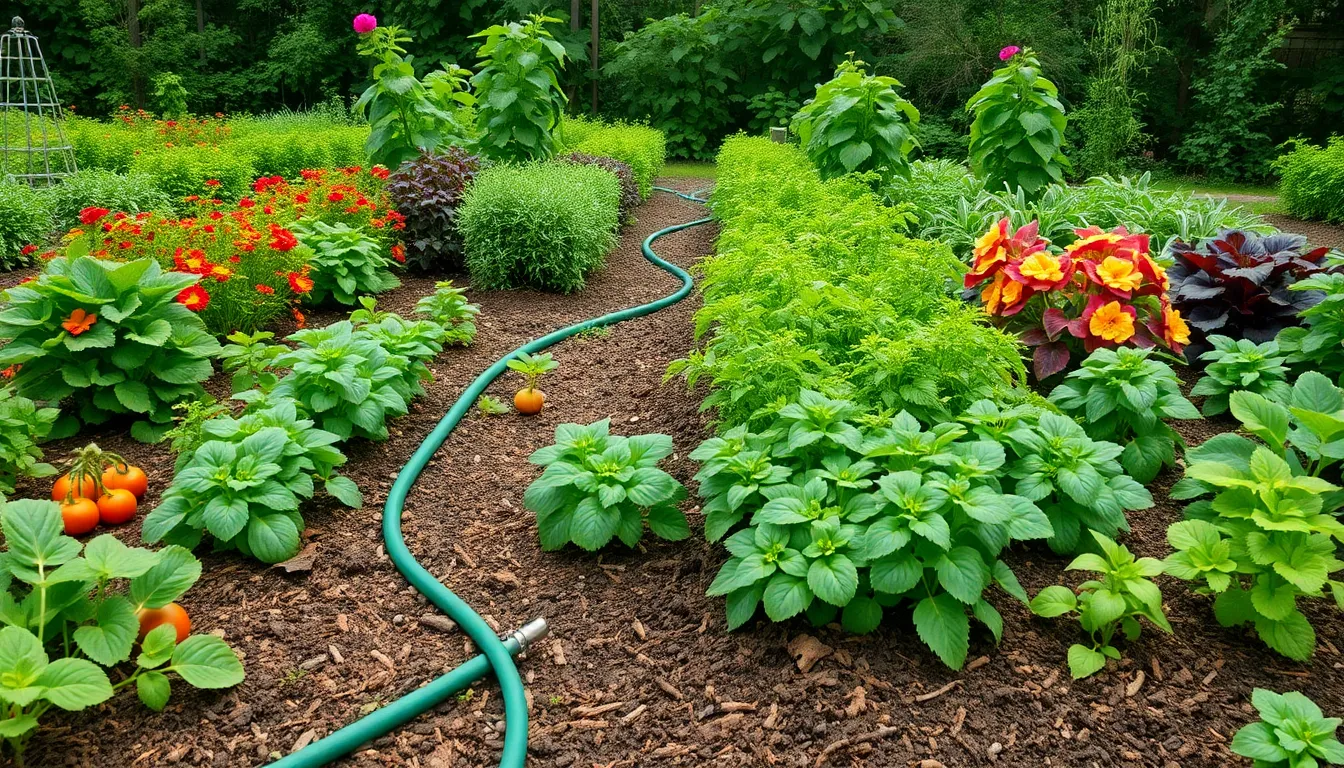
Once we’ve established our garden beds and selected our plants, the next crucial step involves creating systems that’ll keep our kitchen garden thriving with minimal daily effort.
Install Drip Irrigation Answers
Drip irrigation systems deliver water directly to plant roots, reducing water waste and creating the most efficient watering method for our kitchen gardens. These systems conserve water while minimizing soil erosion, making them ideal for sustainable gardening practices.
Soaker hoses provide an alternative approach that distributes water evenly across garden beds without requiring individual emitters. We can lay these porous hoses throughout our planting areas to achieve consistent moisture distribution.
Automatic timers paired with drip irrigation ensure our plants receive consistent watering schedules regardless of our daily routines. Smart controllers can adjust watering frequency based on weather conditions, preventing overwatering during rainy periods and increasing irrigation during dry spells.
Create Mulching Plans
Organic mulch materials like straw, grass clippings, and wood chips retain soil moisture while suppressing weed growth naturally. These materials break down over time, adding nutrients to our soil and improving its overall structure.
Maintaining a mulch layer of 2-3 inches depth provides optimal moisture retention without overheating plant roots. This thickness prevents excessive evaporation while allowing air circulation around our vegetables and herbs.
Seasonal mulch renewal keeps our garden beds healthy throughout the growing season. We should refresh organic mulches every few months as they decompose, ensuring continuous weed suppression and moisture conservation.
Schedule Regular Harvesting Times
Regular harvest checks every other day ensure optimal freshness and encourage continuous plant growth. Frequent harvesting signals plants to produce more leaves, fruits, and pods, maximizing our garden’s yield potential.
Crop rotation schedules maintain soil health by preventing pest accumulation and nutrient depletion. We should plan seasonal rotations that move plant families to different bed sections, breaking pest and disease cycles naturally.
Garden journal records track planting dates, harvest times, and growing observations for future season improvements. Documenting our successes and challenges helps us refine our gardening techniques and timing for better results year after year.
Conclusion
Starting our kitchen garden journey doesn’t have to be overwhelming or require extensive space. We’ve explored countless possibilities that can transform any area into a productive growing space—from compact container setups to sophisticated vertical systems.
The beauty of kitchen gardening lies in its flexibility and immediate rewards. Whether we’re nurturing quick-growing leafy greens on a windowsill or establishing raised beds with companion plantings we can customize our approach to match our lifestyle and available space.
With proper planning and the right techniques we can enjoy fresh herbs vegetables and fruits year-round. Our kitchen gardens will not only enhance our meals but also connect us more deeply with our food while reducing grocery expenses and environmental impact.
Frequently Asked Questions
What is a kitchen garden and why should I start one?
A kitchen garden is a dedicated space for growing herbs, vegetables, and fruits used in cooking. Starting one provides fresh, flavorful ingredients right at your fingertips, reduces grocery costs, and connects you with nature. It’s accessible for all skill levels and can fit various spaces, from large backyards to small balconies, enhancing your cooking while promoting sustainable living.
Can I grow a kitchen garden in a small space or apartment?
Absolutely! Small spaces are perfect for kitchen gardens using container gardening, vertical systems, wall-mounted planters, and hanging baskets. You can grow herbs on windowsills, use fabric grow bags on balconies, or create tiered shelving systems. These space-efficient solutions allow apartment dwellers to enjoy fresh produce without requiring a traditional garden plot.
What containers work best for kitchen gardening?
Choose containers based on your plants’ root systems – shallow containers for herbs, deeper ones for vegetables. Ensure proper drainage holes to prevent root rot. Lightweight options like fabric grow bags and wheeled planters offer flexibility for repositioning. Container size should match plant needs: 6-8 inches deep for herbs, 12+ inches for larger vegetables.
Which herbs should I grow for cooking?
Focus on frequently used culinary herbs like basil, thyme, rosemary, parsley, oregano, and chives. Position these near your kitchen in raised beds or window boxes for easy harvesting. Group herbs by similar water and light requirements for optimal growth. These essential herbs will transform your cooking while being relatively low-maintenance for busy schedules.
How can I maximize vertical space in my kitchen garden?
Use wall-mounted planters, pocket planters made from fabric or canvas, tiered garden shelves, and hanging basket arrangements. These systems transform walls into productive growing areas and allow trailing plants to grow above eye level. Vertical gardening maximizes space efficiency while maintaining accessibility and aesthetic appeal in limited areas.
Can I grow vegetables indoors year-round?
Yes! Focus on cold-hardy vegetables like kale, spinach, Brussels sprouts, and broccoli that thrive in cooler temperatures. Invest in quality LED grow lights to provide necessary light spectrum during darker months. Maintain consistent temperature control using space heaters and monitoring devices to create a stable growing environment regardless of outdoor weather.
What are the benefits of raised beds for kitchen gardens?
Raised beds improve drainage, soil quality, and accessibility while reducing maintenance. They allow for better organization through crop segregation, companion planting zones, and seasonal rotation areas. You can easily build structures like trellises for climbing plants and implement efficient irrigation systems, leading to better harvests with less effort.
Which vegetables grow fastest for quick harvests?
Leafy greens and microgreens like arugula, spinach, and mizuna mature in just weeks. Root vegetables such as radishes can be harvested in as little as 18 days. Choose cut-and-come-again varieties that allow continuous harvesting without replanting, maximizing garden efficiency and providing steady fresh produce for your kitchen.
What is companion planting and how does it help?
Companion planting involves growing compatible plants together for mutual benefits. Examples include tomatoes with basil and carrots with onions, which enhance yields and reduce pest issues. This strategy creates a naturally balanced ecosystem, improves soil nutrition, and provides natural pest control without chemicals, making your garden more productive and sustainable.
How do I set up efficient watering systems for my kitchen garden?
Install drip irrigation or soaker hoses for targeted watering, and use automatic timers or smart controllers for consistency. Apply organic mulch to retain moisture and suppress weeds. Schedule regular harvests to maximize yields, and maintain a garden journal to track progress and refine your techniques over time for optimal results.

